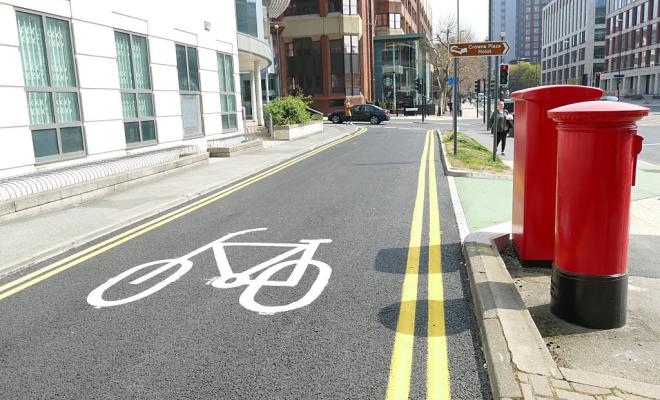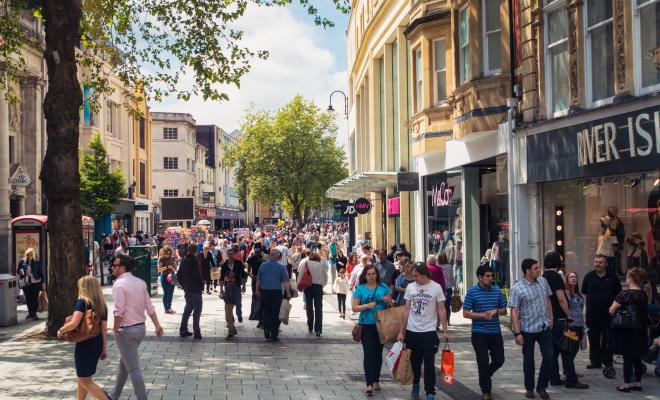09 Nov 2023
Councils, climate and transport
Transport is the largest source of UK greenhouse gases, responsible for more than a third of climate change emissions when you include international aviation and shipping. In addition, air pollution from vehicles is having a detrimental impact on our health, with poorer communities and people of colour disproportionately exposed to high levels of air pollution despite having lower car ownership.
Transport is also key to places being safe and accessible for everyone, including whether people can access jobs and healthcare via convenient and affordable public transport or safe walking and cycling routes. A government survey showed that from 2015-2019 black people were more than twice as likely as white people to live in a household with no access to a car or van, showing that investment in transport is vital for equity as well as the climate.
The government published its long-awaited transport decarbonisation plan in July 2021, but while it cited shifting from car use to active travel and public transport as a central goal, the government’s plan didn't shift on its major road-building aims as part of its £27 billion roads programme. As of November 2022 detailed guidance for local authorities on decarbonising Local Transport Plans hasn’t yet been released (although when it is it should helpfully require quantified carbon reduction), and powers to act on transport vary depending on the type of council, but all councils can play their part and help reduce the huge emissions produced by transport. Councils should:
- prioritise investment in more sustainable modes of transport such as cycling, walking and public transport, including trams. Your council could make your local area more cyclist and pedestrian friendly by installing segregated cycleways on most roads, increasing space for pedestrians and introducing a 20 mph speed limit in urban areas, which can also cut emissions. Combined and unitary authorities should also invest in public transport improvements. Confused about what type of council yours is and how it works? Take a look at our guide on understanding how your council works.
- encourage a reduction in car use, including by constraining and re-allocating road space. Not only will this help reduce levels of climate-wrecking greenhouse gas emissions, but it’ll also tackle air pollution and make your area safer for those who travel by bike or foot. It can also speed up journeys for public transport and essential road use. Councils can discourage the use of polluting vehicles by establishing School Streets, well-designed Low Traffic Neighbourhoods and Clean Air Zones, which introduce charges for the most polluting vehicles, or restrict them from entering the area altogether. They can also take action by promoting car sharing, introducing differential charges for parking permits (see below for more info) or implementing a Workplace Parking Levy, which can in turn help to pay for public transport improvements. However, it needs to be easy and affordable for people to access greener alternative ways to get around – including safe walking and cycling and free local public transport – for the above measures to be effective and equitable.
- make places more accessible and less car dependent. The Local Plan is an important tool for this. Councils can exercise their land-use planning responsibilities to plan for less car use by ensuring that any new homes are located close to public transport and have good-quality cycle and walking routes to shops and services.
- cut emissions from remaining car use by encouraging a switch to electric vehicles. It’s important to note that some people will need to use a car for mobility or other reasons. However, reducing the number of cars on the road overall will also make it easier for those who require a car to get around. Where cars are needed, councils must do what they can to ensure these vehicles are as green as possible by installing electric vehicle charging points, using licencing powers to require all taxis to be electric and rapidly transitioning any vehicles owned by the council to electric vehicles. However, electric vehicles are only part of the solution as they, along with all vehicles, still produce carbon emissions during manufacture, and produce dangerous fine particles of air pollution from brake and tyre wear and road abrasion.
The target
Councils need to play their part in helping to meet climate goals and the World Health Organisation’s (WHO) air pollution guidelines, as well as in making places more accessible for people without cars. With existing resourcing and powers, a reasonable target for councils to aim for is:
To significantly and rapidly increase the proportion of people that travel by cycling, e-bike and walking, as well as public transport.
Challenges
The Department for Transport has been rewriting its strategies and plans for transport. It says it’s going to bring them in line with the need to reduce emissions to net zero. So far, it’s produced a transport decarbonisation plan, a vision for walking and cycling, an active travel toolkit and a bus strategy.
This does represent progress, but funding for public transport is still well short of what’s needed. For example, while some bus improvement funding has been made available, it’s only reaching a minority of local areas. With poorer households generally more dependent on bus services, this isn’t just a failure to tackle emissions but also to help people access the services they need.
Key guidance for local authorities on decarbonising Local Transport Plans and the Rural Transport Strategy have both been delayed, and the government remains wedded to road-building (and airport expansion). The government has however issued a toolkit for local authorities on transport, including some case studies, which are useful for seeing what could be replicated in your area. Meanwhile the government’s advisor the Climate Change Committee is urging stronger action on transport.
Some councils are still promoting more road building (and the expansion of aviation). While they may say they’re simply following national government’s example, we need to see local leadership on moving away from high-carbon infrastructure.
Councils leading the way
Some councils are already making strides towards more sustainable transport. Share these examples with your council using this template email and help inspire them to take action.
Cutting traffic in Nottingham through the council’s parking levy has already saved 7,840 tonnes in carbon dioxide (CO2) emissions and improved air quality, with the levy used to fund better public transport. The council says it’s creating a more equal city, with increased options for disabled people and residents without private vehicles. Physical activity is also on the rise due to new opportunities for active travel.
Stroud District Council is reducing car journeys using a settlement hierarchy – a planning tool that aims to keep homes, jobs and services as close together as possible so that people’s daily needs are met on their doorstep. The hierarchy will also make sure developments support new infrastructure for sustainable travel, such as walking and cycling.
In County Durham, 43% of residents live in rural areas and 40% of housing is terraced with no off-street parking, so electric vehicle charging points are a challenge. Durham County Council has placed accessible, public charging points at the centre of its plans to promote electric vehicles, and it’s already installed 200. The council is also making sure local charging points are designed to be accessible to people with disabilities.
Local authorities (and their residents) in England can also use their influence as members of sub-national transport bodies to align their region’s transport strategy with climate targets. For example, England’s Economic Heartland adopted a transport strategy with a vision for a decarbonised transport system.
Learn from others
Some groups have already been working within their communities to combat the issue. For example, Hope Valley Climate Action (HVCA) has led the way in championing sustainable transport in the local area with its “Travelling Light” scheme. The group is working in partnership with Derbyshire County Council and the Peak District National Park Authority to promote low-carbon travel in popular rural areas. The project, which is part-funded by the Department for Transport, aims to make cycling and walking the best options for short journeys, increase the take-up of improved public transport and reduce private vehicle use for travel into, and within, the Valley. Actions HVCA is taking include:
- pressing for policy change to reduce speed limits within residential areas and on backroads, in line with the philosophy of the “20’s Plenty” campaign.
- educating, raising awareness and running events to build support for lower speed limits within the community.
- improving cycle lanes and access to e-bikes.
- promoting peer-to-peer car sharing via existing platforms and co-ordinating co-op car sharing at a village level, where groups or pairs within villages own a vehicle collectively and share fuel and repair costs.
- improving transport connectivity at key rail stations to form hubs for public transport and active travel.
Another group that’s successfully persuaded its council to take action is Tottenham and Wood Green Friends of the Earth. The group secured a commitment from Haringey Council to introduce higher parking permit prices to reflect the pollution that a vehicle causes. By building a relationship with the Cabinet Member for Neighbourhoods, highlighting the disproportionate impact of air pollution on poorer households and people of colour, and coordinating an email campaign from local people to their councillors, it persuaded the council to introduce higher parking charges for diesel-fuelled vehicles and for households with 2 or more vehicles. Income from these charges can now be used to help pay for measures to facilitate walking and cycling – making Haringey safer to travel around and helping reduce air pollution and carbon emissions.
Convince your council
If you’re keen for your local authority to prioritise transport, then one of the best ways of convincing them is by building alliances with others in the community and demonstrating the public demand for action. This is very clear in the case of the Hope Valley Travelling Light scheme (see above), where the local action group HVCA initiated the project – including raising funds, carrying out feasibility studies and engaging local people. The project is now supported by key local authorities and transport operators who'll work with HVCA to design and deliver a range of solutions.
It’s worth knowing that councils are more amenable to introducing schemes that have a wide array of benefits, as it generally means they’re more cost effective. Point out that measures to cut car use will also deliver health benefits. For example, Southwark Council’s partnership with Guy’s and St Thomas’ NHS Foundation Trust (which contributed funding to the council) has targeted measures at specific locations to benefit vulnerable communities. Pilot schemes – to encourage more walking and cycling – were run in low-income areas with schools, poor air quality and above-average levels of childhood obesity.
Councils are understandably concerned about resourcing, and short-term, competitive funding from national government doesn’t help. But the health benefits can create financial benefits too – Leicester City Council has estimated that every £1 invested in its decarbonising transport project will create £2.84 in wider benefits related to health and wellbeing. Higher levels of exercise are expected to boost local people’s health and lower mortality rates, while also reducing absenteeism in the city’s workforce.
Councils can also be wary about introducing what they perceive to be controversial measures such as Low Traffic Neighbourhoods. These need to be well designed, and you may be able to help your council with community engagement – successful councils point to early and meaningful community engagement as crucial in introducing these kind of measures. For example, Waltham Forest found that reaching out to trusted local stakeholders before embarking on a wider consultation was important, and that demonstrating what the changes would actually be like helped to get people on board. It also recognised that some compromise may be needed to address residents’ concerns.
Lastly, it’s worth looking for opportunities to improve plans and strategies that local authorities are already required to produce. Look out for consultations on new or updated Local Plans and Local Transport Plans (LTPs). All local authorities outside of London will need to have an updated LTP, probably by 2024, with a new emphasis on decarbonisation – this is a big opportunity to ensure ambitious targets as well as strong measures to cut traffic and boost walking, cycling and public transport.
Funding and powers
Action by central government will empower councils to do more. Councils can and are acting now, but it’s hard to find a council able to act across all the areas they need to and at the scale and pace commensurate to the climate and ecological emergencies. That’s why they need additional powers and resources. Central government can help by:
- cutting funding for new roads and increasing funding to local authorities to deliver measures for active travel and public transport.
- setting targets to cut car miles by at least 20% by 2030, for both the climate and air quality, by amending the Road Traffic Reduction Act and introducing road user charging or pay-as-you-drive, which would replace other charges.
- ensuring that funds directed at “levelling up” and “shared prosperity” are aligned with climate targets and can be used to improve active travel and public transport.
- giving local authorities additional powers to raise funds locally, including for public transport (eg via a payroll levy, as is widely used in France).
- publishing long-awaited guidance for local authorities on Local Transport Plans, with an emphasis on reducing the climate impacts of road traffic, as well as its detrimental social and economic impacts.
- including a stronger emphasis in national planning policy on sustainable locations – where people live closer to key services and can access everything they need via active travel and public transport – so that new developments can’t be car dependent.
- ramping up support for the installation of electric vehicle charging points.
- bringing forward the date proposed in the Environment Act for meeting dangerous fine particles targets to 2030 – which would put us on the way to meeting new recommendations from the WHO – and revise other air pollution targets.
Friends of the Earth has joined local government organisations, academics and other NGOs in setting out a Blueprint of what’s needed from national government to support councils in key policy areas, including transport. The coalition has assessed how the government is doing so far in its progress tracker. Be sure to ask your council to sign up to the Blueprint if it hasn't done so already.
Helpful resources
Find out what progress your local area has already made on this topic with our handy data tool, “Near you”.
Watch our training video and learn what your council can do to back sustainable, accessible transport:
Find out how you can build a strong campaign to push your council to take ambitious action in this area.
Get to grips with how your council works.
Find out more about Local Transport Plans and the transport powers of different local authorities.
Read more examples of best practice by councils.
Find out how your council is doing by looking at its Council Climate Action Scorecard, created by Climate Emergency UK.
Find out more about air pollution and why we need cleaner air.
See more details on what we're calling for on air quality.
Read more about what local authorities can do to cut car use.
Read this summary transport policy paper.
Check out information and support on fighting road schemes.
Find out more about Low Traffic Neighbourhoods.



